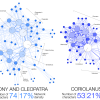Source: Approaches to Digital Bibliography and Book History: Ontology Reference
What follows is a loosely organized collection of links and information both about commonly used ontologies and about working with ontologies in OWL. The information is presented as part of the instructional material for my Rare Book School course on Approaches to Digital Bibliography and Book History, co-taught with Benjamin Pauley.
The course unit involves both reading and creating OWL ontologies. While there are many ways to do this, I recommend that you do so using Stanford’s Protege tool. You can get the app from their website or download the appropriate package here [windows, Mac].
Protege is a very complex and robust tool, but you don’t need to be familiar with all the complexity, as we won’t be drilling down that far in our course exercises. We’ll go over the basics that you need in class, but a couple of good and fast tutorials can be found here: Pizza Ontology in 10 Minutes [wiki] and Protege YouTube Tutorial [00:01:44].
There are many (and I mean many) ontologies out there. The following pages provide aggregated lists of various ontologies currently in use:
Library of Congress Standards
Protege Ontologies
Ontologies developed using Protege
TONES Ontology Repository
For convenience, I’v zipped up a collection of the most commonly used ontologies in the library, cultural heritage, and humanities domains presented in OWL or Turtle format: ontologies.zip
Below is a collection of links to more information about each of the ontologies included in the ontologies.zip file (presented in no particular order):
Dublin Core
Metadata Object Description Schema (MODS)
Simple Knowledge Organization System (SKOS)
Prov-O: The PROV Ontology
CIDOC-CRM
Friend of a Friend (FOAF)
Other ontologies not included in ontologies.zip (for reasons of containment and scale) but that are frequently used in library and digital scholarship description are:
RDA Registry
The Bibliographic Ontology
International Standard Bibliographic Description (ISBD)
All of the above ontologies offer unique ways to describe particular things. (With the exception, perhaps, of Dublin Core, which aims to generally describe everything.) Another type of ontology is what can be thought of as a meta-ontology: an ontology that combines and organizes other ontologies to describe objects in a complex way. In class we will be discussing and/or using the following meta-ontologies:
Functional Requirements for Bibliographic Records (FRBR)
Schema.org
BIBFRAME
Finally, those with experience in libraries and archives (digital or otherwise) might notice the absence of two popular encoding schemes: EAD and METS. Both are excluded from this discussion (and could end up being excluded and replaced in descriptive practice) because neither have been updated from older, XML formats to more flexible and robust triples-based formats like OWL. This makes them unsuitable for use in the era of Linked Data.
What follows is a bit more information based on requests from students during class.
In class we worked as a group to design an ontology for broadside ballads. The JISC funded Integrating Broadside Ballads project worked on this problem for two years in an attempt to come up with a shared ontology for describing ballads. This ontology can be found here. It is still very much a work in progress, but it reflect the thinking of some of the leading ballad scholars in the world on the edges presented by the broadside ballad. As such, it provides a good starting point for further discussion.
Students also asked for information about Linked Data, ontology production, and publishing of Linked Data. The following are some good, informative resources:
Semantic Publishing
W3C OWL Faq
W3C Ontology Use Cases and Requirements
W3C OWL Over of Machine Readable Function
KOMMA Eclipse Plugin: IDE for editing RDF and OWL (Requires Eclipse)
Apache Marmotta: Server-side software for storing and publishing RDF





